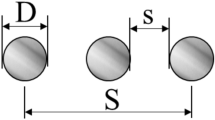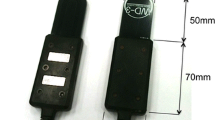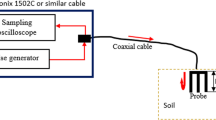Abstract
Thermo-TDR probes can function both as a regular time domain reflectometry (TDR) probe, for measuring moisture and density, and a dual-heat probe for measuring thermal conductivity, thermal diffusivity, and volumetric heat capacity. The probe measurement sensitivity and accuracy are affected by probe length, diameter, and spacing. In this paper, two thermo-TDR probes were fabricated based on an improved design of a previous one. The two probes were first calibrated for measurement of dielectric constant and electrical conductivity using standard chemical solutions. Then, moisture, density, and thermal measurements were taken in custom designed compaction molds filled with ASTM fine-grade compacted sand using the thermo-TDR probes as well as KD2 probes. Calibrations are reported for the thermo-TDR probes measuring soil moisture, density, and thermal conductivity. The effect of sensor fabrication and sample preparation tests are evaluated. Recommendations are provided for using thermo-TDR probes for measuring in sand.
Access provided by CONRICYT-eBooks. Download conference paper PDF
Similar content being viewed by others
Keywords
1 Introduction
Soil thermal properties along with soil moisture and density are the fundamental soil design parameters needed for design and construction of many engineering applications such as soil thermal energy storage, radioactive nuclear waste disposal, underground heat exchangers, and energy piles. Design of these geostructures requires better characterization of heat transfer in the soil, which includes heat conduction, convection, and radiation. Soil thermal properties include volumetric heat capacity, thermal diffusivity, and thermal conductivity. Needle-like heat probes are commonly used to measure soil thermal properties based on the line heat source theory. The thermal properties of the soil are obtained by back-calculation of the measured temperature response curves of heat probes subjected to a short heat pulse (Welty 1976).
The time domain reflectometry (TDR) technology is a quick, dependable, and safe method for soil moisture content measurement, both in the field and laboratory (Topp et al. 1980; Yu and Drnevich 2004; Yu et al. 2015). Liu et al. (2008) examined four probe designs for measurement of soil bulk density, volumetric water content, and volumetric heat capacity. Yu et al. (2015) developed a thermo-TDR probe for laboratory measurement of soil moisture, dry density (bulk density), and thermal conductivity in compacted soil specimens.
TDR probe measurement sensitivity and accuracy are affected by probe length, diameter, and spacing. Previous studies have been conducted on probe design and performance evaluations. However, more studies are needed to optimize probe design for a comprehensive evaluation that can provide better measurements of soil moisture, dry density, and soil thermal properties of compacted soil specimens. In this study, two thermo-TDR probes were fabricated based on a modified probe design to comprehensively evaluate individual sensor performances and sample preparation methods for thermo-TDR measurements.
2 Sensor Design and Fabrication
The design of thermo-TDR probes shall satisfy the requirements of both TDR and dual probe heat pulse (DPHP) probes. The major design restraints of the TDR moisture probes include signal attenuation, sampling area, and sensor installation. The length of the probe is determined by the source voltage of the pulse generator, resolution of recorded signals, and signal loss, which is dominated by soil electrical conductivity (Ren et al. 1999). Ren et al. (1999) state that probe-to-probe spacing to probe diameter ratio should be less or equal to 10 as shown in Eq. 1. Design of a DPHP requires a heat source to be close to the infinite line heat source. The design constraints are presented by Eqs. 2–4 (Blackwell 1956; Ren et al. 1999).
where L is the probe length; s is the center-to-center spacing between the center probe and the outer probe, and d is the diameter of the probe. An ired design of the thermo-TDR probe by Yu et al. (2015) was developed as shown in Fig. 1. The probe has a longer length and wider spacing. The probes have a longer length extended into the probe head to increase the stability of probes during insertion.
Details of the fabrication process of thermo-TDR were introduced by Yu et al. (2015). Two thermo-TDR probes were fabricated based on the improved design just described. The two thermo-TDR probes are referred to as T1 and T2. The fabricated length including the tip of T1 and T2 is 54 mm and 53 mm, respectively.
3 Calibration of Dielectric Constant and Electrical Conductivity
3.1 Dielectric Constant and Electrical Conductivity
Apparent dielectric constant and electrical conductivity of the measured soil can be directly determined by analyzing TDR waveforms. The apparent dielectric constant is determined by the Eq. 5 (Topp et al. 1980).
where Ka is the apparent dielectric constant; Lp is the physical probe length, and La is the apparent length of the probe in the testing materials determined from TDR waveforms. The apparent length of the probe in the TDR waveform is determined by locating the electromagnetic wave reflection points at the probe head and end following the single tangent method proposed by Baker and Allmaras (1990).
Electrical conductivity measured by TDR can be determined using Eq. 6 (Giese and Tiemann 1975).
where ECb is the electrical conductivity (Sm−1); εo is the dielectric permittivity of free space; c is the speed of light in vacuum; Zo is the characteristic probe impedance; Lp is the probe length; Zc is the TDR cable tester output impedance; Vo is the source voltage; and Vf is the long-term voltage level of the reflected signal. Details of the calculations of Ka and ECb can be found in Yu et al. (2015).
3.2 Calibration of Dielectric Constant (Ka) and Electrical Conductivity (ECb)
Nine different chemicals with known dielectric constants were used to calibrate the dielectric constant Ka. Because the values of Ka for most testing soils are less than 20, only three different chemicals were selected for dielectric constant calibration. TDR waveforms of the chemicals and air are shown in Fig. 2. Calibrations of an apparent dielectric constant for T1 and T2 are shown in Fig. 3. The two probes have very similar calibration equations with high accuracy.
The calibration of thermo-TDR for electrical conductivity measurement was performed by measuring NaCl solution of different concentration using the thermo-TDR probe as well as an EC meter. The electrical conductivity by the thermo-TDR probe is compared with the EC meter measurement as shown in Fig. 4. The calibration results show that thermo-TDR can satisfactorily measure both dielectric constant and electrical conductivity with an R2 of 0.99. The calibration equations of T1 and T2 are almost identical and can be used interchangeably with acceptable errors.
4 Thermal Properties
A DC current source was connected to the resistance wire in the thermo-TDR center probe to generate a heat pulse in the center probe. The temperature variations of the three probes were recorded. Their temperature response can be predicted by the infinite line heat source theory as shown in Eq. 7 (De Vries 1952; Kluitenberg et al. 1993).
where T is the temperature change; Q is the strength of line heat source; α is the soil thermal diffusivity; Ei(x) is the exponential integral; r is the radial distance; t is the time, and to is the duration of the heat pulse.
The volumetric heat capacity, thermal diffusivity, and thermal conductivity were calculated using Eqs. 8–10.
In these equations, r is the radial distance between the center probe and outer probes; tm is the time when the maximum temperature of the outer probes occurred; Tm is the maximum temperature increase of outer probes. Details of the analysis of heat pulse response curves can be found in Yu et al. (2015). Only thermal conductivity measurement is discussed in this paper. KD2 pro sensors include TR1 for measurement in soil and KS1 for measurement in liquids. Although KS1 is not recommended for soil, it was used to measure the thermal conductivity of ASTM fine-graded sand to evaluate the effect of probe size and heating pulse.
5 Test of Thermo-TDR Probes in ASTM Fine Graded Sand
Figure 5 shows the schematic of the experiment setup. The thermo-TDR probe inserted into the compaction mold is connected to the Campbell Scientific TDR100 through a coaxial cable to collect TDR waveforms. The resistance wire is connected to the DC power supply BK PRECISION 17850B to heat the soil specimens. Three thermal couples are connected to the thermocouple data logger Pico USB TC-08 to record temperature variations of the center probe and outer probes every second.
ASTM fine graded sand was selected to evaluate the two thermo-TDR probes for measurement of soil moisture, dry density, and thermal conductivity. The ASTM fine graded sand is Ottawa-type silica sand with a white color and round-to-subrounded shape. Total 4 group tests were performed to evaluate the effect of the sample preparation method and repeatability of test results. Each test group includes compaction of sand at various desired moisture content levels using custom-designed PVC compaction molds. The dimensions of the compaction mold and the extension collar are shown in Fig. 6.
For all test groups, dry sand samples were hand mixed with tap water at a desired mass ratio in a metal bowl and kept for 30 min before compaction. For the first test group, the prepared wet soil sample was poured into the compaction mold until the extension collar was full and then a beaker was used to compress the soil by hand compression. For the second test group, the prepared soil sample was poured into the compaction mold with extension collar until full and then a standard compaction rammer was used to compact the soil with the hammer raised to 10 cm above the soil surface. For Tests 3 and 4, the prepared soil samples were compacted at three equal lifts to reach the height of the compaction mold with the hammer at its full height of 30 cm. The soil compaction methods are illustrated in Fig. 7.
After the sand specimen was compacted by employing the procedure described in the above section, the thermo-TDR probe T1 was inserted into the sand with the probe head in close contact with the sand surface. During insertion, the probe should be kept vertical to maintain the probe in close contact with surrounding soils. Two TDR waveforms were acquired consecutively using PM-TDR SM Version 1.7. Then the DPHP test was performed by supplying a DC current of 0.15 A for 15 s. The thermocouple readings were acquired using a PicoLog Recorder. These above measurements were repeated one more time, and a total of four TDR waveforms and two heat pulse responses were recorded. The procedure was then repeated for probe T2. After the thermo-TDR probe tests, two heat probes, KD2 TR-1 and KS-1, were inserted into the specimens separately for heat pulse tests following the procedure recommended in the operation manual. Two readings were taken for each probe. After all the measurements were taken, two soil samples were collected from the top third of the compaction mold to determine oven-dry moisture content. Test 1 and Test 2 were performed with the compaction mold in a vertical position, while Tests 3 and 4 were conducted with the mold kept in a horizontal position to maintain uniform moisture along the height. For Tests 3 and 4, two compaction molds were used to prepare two identical compacted specimens for T1 and T2, respectively. Test 3 and 4 also reduced the time lapse between thermo-TDR and KD2 measurement.
6 Calibration of Thermo-TDR for Moisture and Dry Density
One step method proposed by Yu and Drnevich (2004) was used to develop calibration equations for measurement of the gravimetric moisture content and dry density. This method adopts two calibration equations shown in Eqs. 11 and 12 based on measured apparent dielectric constant and electrical conductivity of the measured soils.
Here, a, b, c, and d are specific calibration constants; ρd is the dry density of soil, kg/m3; ρw is the density of water, kg/m3, and ω is the gravimetric moisture content, (based on percentage). Thus, gravimetric moisture content and dry density can be evaluated by solving Eqs. (11) and (12).
The calibration relationships for thermo-TDR probe T1 and T2 are presented in Figs. 8 and 9. Figures 8 and 9 present the calibration based on dielectric constant measurement and electrical conductivity respectively. Notably, the calibration equations from Test 1 and Test 2 significantly deviate from Test 3 and Test 4, especially calibration as per Eq. 11. Specimens were not compacted uniformly in Test 1 and Test 2 because the soil was compacted in one lift. This leads to large errors when average specimen moisture and dry density are used in the calibration. T2 has larger calibration errors compared to T1 in Test 1. It might be caused by the long-time gap between the testing of T1 and T2 due the time required for thermal testing. Long testing time causes moisture loss at the sand surface due to evaporation and possible heating loss, which leads to measurement errors. Test 3 improves sample compaction homogeneity by compaction of three equal soil lifts. Test 3 and Test 4 reduce the time lapse between measurements by T1 and T2 by providing two soil specimens. The two calibration equations in Test Groups 3 and 4 were closely matched and are considered repeatable.
7 Calibration of Thermal Conductivity Measurement
Comparison of measured thermal conductivity between thermo-TDR probes and KD2 TR-1 (long) probe for T1 and T2 are shown in Fig. 10(a) and (b), respectively. A comparison of measured thermal conductivity between thermo-TDR probes and the KD2 KS-1 (short) probe for T1 and T2 are shown in Fig. 11(a) and (b), respectively. Figures 10 and 11 show that TR-1 has a larger measurement range of thermal conductivity as compared with KS-1. Both Thermo-TDR probes yield a close match of TR-1 measurements. Sample preparation methods are much less effective when compared to moisture and density measurement. However, the loose compaction method in Test 1 still has a noticeable effect on thermal conductivity measurement. Figure 11 shows that the thermal conductivity measured by the KS-1 sensor is much smaller than that measured by the thermo-TDR probes. KS-1 sensors are designed for liquids and lose accuracy in sand.
8 Conclusions
In this paper, an improved thermo-TDR probe design was introduced, and two thermo-TDR probes were fabricated and tested comprehensively. Calibrations of thermo-TDR probes for dielectric constant and electrical conductivity show high accuracy and close repeatability of measurements. The developed thermo-TDR probes were tested in ASTM fine graded sand compacted using four different preparation methods for verification of moisture, dry density, and thermal conductivity measurement. Non-uniform compaction and a long-testing time lapse led to different calibration results. The specimens were compacted uniformly at three lifts with consistent compaction efforts that yielded repeatable calibration of the two thermo-TDR probes. The calibration of moisture content and dry density were highly accurate with an R2 greater than 0.97. Only TR-1 should be used for thermal conductivity measurement in wet sand. Both thermo-TDR probes yielded highly repeatable results of TR-1. Proper care must be taken to carefully prepare uniform compacted specimens and ensure vertical insertion for close soil-probe contact for accurate thermo-TDR measurements.
References
Baker, J.M., Allmaras, R.R.: System for automating and multiplexing soil moisture measurement by time-domain reflectometry. Soil Sci. Soc. Am. J. 54(1), 1–6 (1990)
Blackwell, J.H.: The axial-flow error in the thermal-conductivity probe. Can. J. Phys. 34(4), 412–417 (1956)
De Vries, D.A.: A non-stationary method for determining thermal conductivity of soil in SITU. Soil Sci. 73(2), 83–89 (1952)
Giese, K., Tiemann, R.: Determination of the complex permittivity from thins sample time domain reflectometry: implications for twin rod probes with and without dielectric coatings. Water Resour. Res. 32(2), 271–279 (1975)
Kluitenberg, G.J., Ham, J.M., Bristow, K.L.: Error analysis of the heat pulse method for measuring soil volumetric heat capacity. Soil Sci. Soc. Am. J. 57(6), 1444–1451 (1993)
Liu, X., Ren, T., Horton, R.: Determination of soil bulk density with thermo-time domain reflectometry sensors. Soil Sci. Soc. Am. J. 72(4), 1000–1005 (2008)
Ren, T., Noborio, K., Horton, R.: Measuring soil water content, electrical conductivity, and thermal properties with a thermo-time domain reflectometry probe. Soil Sci. Soc. Am. J. 63(3), 450–457 (1999)
Topp, G.C., Davis, J.L., Annan, P.: Electromagnetic determination of soil water content: measurements in coaxial transmission lines. Water Resour. Res. 16(3), 574–582 (1980)
Welty, J.R., Wicks, C.E., Wilson, R.E.: Fundamentals of Momentum, Heat, and Mass Transfer, 2nd edn. Wiley, New York (1976). OCLC 2213384. ISBN 978-0-471-93354-0
Yu, X., Drnevich, V.P.: Soil water content and dry density by time domain reflectometry. J. Geotech. Geoenviron. Eng. 130(9), 922–934 (2004)
Yu, X., Zhang, N., Pradhan, A., Thapa, B., Tjuatja, S.: Design and evaluation of a thermo-TDR probe for geothermal applications. Geotech. Test. J. 38(6), 864–877 (2015)
Author information
Authors and Affiliations
Corresponding author
Editor information
Editors and Affiliations
Rights and permissions
Copyright information
© 2018 Springer Nature Singapore Pte Ltd.
About this paper
Cite this paper
Wang, X., Yu, X. (2018). Evaluation of Two Thermo-TDR Probes for Soil Moisture, Density, and Thermal Conductivity. In: Shi, X., Liu, Z., Liu, J. (eds) Proceedings of GeoShanghai 2018 International Conference: Transportation Geotechnics and Pavement Engineering. GSIC 2018. Springer, Singapore. https://doi.org/10.1007/978-981-13-0011-0_5
Download citation
DOI: https://doi.org/10.1007/978-981-13-0011-0_5
Published:
Publisher Name: Springer, Singapore
Print ISBN: 978-981-13-0010-3
Online ISBN: 978-981-13-0011-0
eBook Packages: Earth and Environmental ScienceEarth and Environmental Science (R0)















